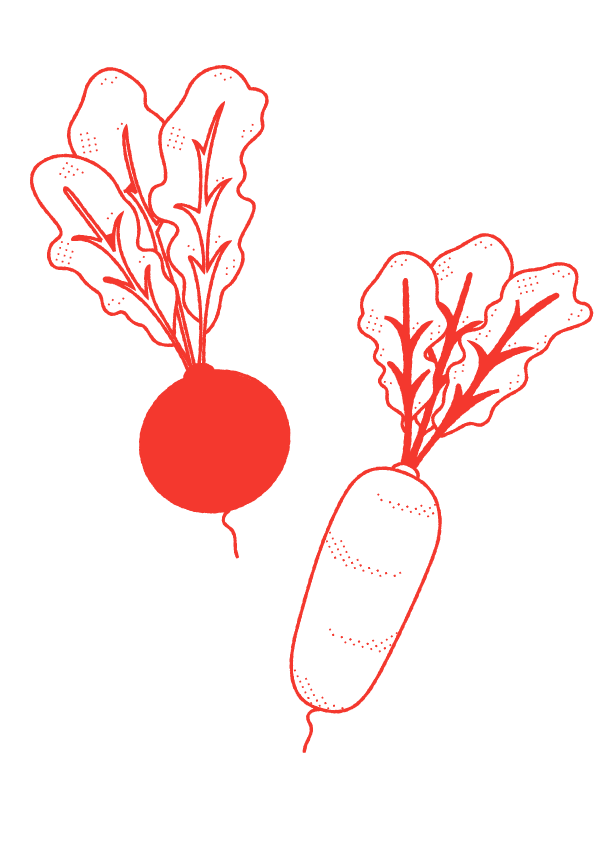Kale
Kale has risen back to popularity in our more health conscious society. What was once considered a bitter winter vegetable is now a hip fresh ingredient with endless new recipes. Wondering what gives your green juice that colour or what the crinkly leaves in your superfood salad is? It might just be kale!
In the Netherlands and Germany, kale has been a staple winter vegetable for generations, often eaten as a one-pot mash potatoes dish. The Dutch word for kale, boerenkool, is why this plant is also known as borecole.
In the UK it has been popular winter vegetable since the second world war. So, what caused it to make the leap into the health food craze?
Some attribute its rise to fame to an American PR firm wanting to promote a more nutrient-rich diet. Their campaign was extremely successful, it has brought about a revival for kale. I, for one, am happy that kale has gotten the recognition it deserves as a great source of vitamins A, K, C and E with plenty of fibre and minerals.
History
Kale is part of the Brassica family and not surprisingly, like most of the Brassica plant species, finds its original roots around the Mediterranean. There are records of a crinkly leafy green vegetable in ancient Greece as far back as 2000 BC.
By the middle ages, kale had become a staple vegetable throughout most of Europe. Since it is a sturdy species that survives well in colder climates, it was especially popular among farmers in North West European regions such as Scandinavia, the Baltics but also in Scotland. This winter vegetable was so commonplace in Scotland that the word for dinner was kail and it was prepared in a kail-pot.
If we look throughout British history, this leafy green has never truly disappeared from our kitchens. With our cooler climate British farmers rely quite heavily on winter crops and, compared to many of its Brassica relatives, kale is one of the least demanding ones.
Season & Cultivation
There are many kale varieties available in the UK. The Scottish heirloom variety, which is very curly with a blueish green tint, is called Vates Blue Curled Scots. This type is great for cooking.
Other commonly available varieties in the UK are cavolo nero, also referred to as Tuscan kale or dinosaur kale. There is also curly kale and red Russian kale which are sweeter in flavor.
Sowing kale starts in the spring, around April or May although some farmers may choose to plant as late as June. The most important element for cultivating kale is moisture so as long as the soil has good drainage, it will grow nicely. Their need for moisture does mean that British organic farmers have a little more work on their hands when the summer is particularly hot.
There are two moments when kale can be harvested. Those that are harvested earlier on in autumn, so at a younger stage, tend to have thinner and lighter leaves. The younger and more tender leaves are popular for raw food preparations such as salads and juices.
The winter harvest, December to February, has thicker, curlier and larger leaves. This is the harvest that is mostly used in hearty winter meals. There is a slight bitterness to kale that has been left to grow longer so it is best to cook these.
Buying Advice
What to look for depends on which kale variety you are buying. As I mentioned, there are many different types of kale, each with their own characteristics.
For curly kale, look for heads with bright green leaves. These tend to have a lighter colour than the other kale varieties. The darkest variety is dinosaur kale which has longer crinkly leaves with a light stem running through. For both varieties, choose a bunch with crisp leaves.
Scottish kale has its curls at the outer edges of the leaves. It has a flatter and more tender structure. The sweetest Scottish kale variety are found at the end of winter as they gain more flavour after a frost. Those with darker leaves are best suited for cooking while the lighter coloured harvest can be used for raw food preparations.
Red Russian kale has a dusty purple tinge to it. The stems are much longer and the leaves are more narrow with crinkles at the edges. Just like with Scottish kale, this vegetable tastes best when harvested after a frost. This is the most popular kind for salads.
Avoid any kale that has leaves that have started to turn yellow. This means that it is no longer fresh.
When storing kale, try to keep it as airtight as possible in a storage bag in the refrigerator. Kale that has been left in the fridge too long will turn soft and more bitter in taste. Kale does not have a long shelf life, 5 days at the most, so keeping it airtight is very important.
Cooking Advice
There is one piece of cooking advice that applies to all kale varieties. Look at the leaf colour to decide how to prepare it. The lighter the leaves, the younger it is which means that is sweet enough to be eaten raw. The darker the leaves, the better suited for cooked meals.
Another important note on kale is that it should not be cooked for too long. Kale is full of vitamins A, K, C, E and minerals such as calcium, iron, manganese and potassium. However, these nutrients are quickly lost when cooked for too long. The best way to retain the nutrients is to either steam or blanch for a few minutes.
When preparing a salad, remember that kale needs an oil-based salad dressing to bring out its crispness and flavour. A salad dressing with extra virgin olive oil is always a good idea. Adding a little citrus will also help to cut through some of the bitterness.
Lately, kale has become a popular replacement for spinach and is also more popular in an Asian style stir-fry. Its structure holds up well at high heat as long as it is not left in the wok for too long. Add it at the end for best results.
Kale is also a great addition to hearty autumn vegetable soups. It instantly packs the soup with extra vitamins and healthy minerals that give our immune system a boost during the cold weather months.
Finally, perhaps the most trendy preparation; kale chips. Their natural crunch becomes even crispier when baked in the oven with olive oil and spices. Let this be your new favourite healthy homemade snack.



